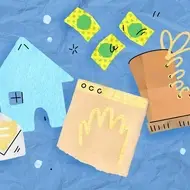The Art of Designing Your Career

Taking an active role in shaping your professional path—whether that means reflecting on your direction, making minor tweaks to an existing role, or finding a new job altogether—is important for career happiness and fulfillment.
Yet many of us give very little thought to being an active architect of our own careers, perhaps because it is scary to contemplate and implement changes. But change is a natural—and even required—part of a healthy career lifecycle, and it all begins with reflection. If you're ready to get started, designing your career from the ground up is a great way to embrace change.
Develop a regular practice of career reflection
A good way to proactively design your career is to regularly reflect on where you want to go. One of my favorite career design quotes (by an anonymous author) is, “Ask yourself if what you’re doing today is getting you closer to where you want to be tomorrow.”
This is a great question to come back to over and over again in order to determine whether you need to course correct a bit. And in the long term, a propensity for personal and professional reflection may allow you to forge a path that is more true to who you are.
One career reflection exercise that may be helpful is this set of questions developed by the University of Michigan. The questions allow you to reflect on what you want most in a job as well as what you like and dislike about your current role. It’ll also enable to you to identify specific changes that you would like to see and to consider your longer-term career goals and how to reach them.
In general, these types of career self-assessments can help you understand what you enjoy doing, your skills and strengths, and your workplace values. Here are a few that I would recommend:
- O*NET Interest Profiler: A free tool to help you identify your interests and which careers may be a match.
- MAPP Career Test: A career test that assesses your likes and dislikes and helps map possible career matches. You can take a free version or pay for a more detailed report.
- Knowdell Career Values (Online) Card Sort: This is a fun, five-minute exercise you can purchase (online version is $12, physical card is $14) to develop a list of values (help society, stability, time freedom) to help you screen for job types and employers.
Consider reshaping your current role
Once you have taken time to reflect on your career, you’ll be in a better position to determine what changes may be required in order to move in a more satisfying direction.
Start by considering smaller changes and whether they can help you reshape your job into the career that you want. Make a list of tasks that you would like to incorporate into your current role and review this list to confirm that these are tasks that are in demand at your workplace. If your desired tasks and in-demand tasks align, this will increase the likelihood of getting buy-in from your organization.
Here’s an example of someone who was able to strategically reshape her current role:
A former colleague of mine, let's call her Sandra, was working as a project coordinator but decided that she wanted to gain management experience by expanding her role. Sandra knew that her supervisor had taken on a lot of new programmatic work and was looking for someone to take on staff-supervision duties, and so she mapped out her request. Upon approaching her director with her plan, he happily obliged and she was able to reshape and grow in her career.
Here’s what Sandra had to say about her experience: "My goal was to make it easy for them to say yes. Present your career aspirations and then connect the dots for the person you are trying to influence. Be specific about the ways in which your growth matches particular organizational needs, fills a gap, or will provide complementary skills needed on the team."
Designing your career to work for you
If tweaking your current role is not an option or if you find yourself in between jobs, you may want to consider a complete career overhaul. I was once laid off from a job and had to really consider what my next step should be. Was I already on the right path, or did I need to change direction?
I ended up making a fairly significant career change and moved from working as a program staff member at a national environmental nonprofit to leading the environmental career services department at a large university.
Although suddenly finding myself without a job was a bit frightening, it was also refreshing to have a completely blank slate. Shifting my attitude made a big difference in my ability and confidence as I moved forward. Here’s what I learned from that experience, and four specific steps that helped me redesign my career:
- Create a list of work projects that brought you joy.
- Start by creating a list of the projects that you most enjoyed working on. Think about what you accomplished and develop a list of skills that you used to achieve those results.
- Brainstorm and research actual job titles and roles that would use the skills identified in step one.
- In applying this exercise to my own professional path, I found that my skills and interests pointed me toward a career as an environmental career advisor.
- Create a list of employers that would hire for these types of roles.
- Think about which employers hire for roles that include the tasks and skills on your list. This is your Target Employer List. When I went through this exercise, I came up with the general category of “colleges” first. Next, I developed a specific list of colleges with environmental-degree programs.
- Identify and address obstacles.
- After you have a list of potential job titles and employers, think about any obstacles that could make it difficult for you to secure these roles, and then brainstorm solutions to these identified obstacles. Perhaps you lack the right degree or maybe you don’t have experience in that sector. Consider what you need to do in order to address any shortcomings. In my case, my preferred employer was seeking a person with a degree in counseling, but my degree was in natural resource management. I emphasized how my experience on multiple hiring teams had given me a unique perspective that would allow me to talk with students about crafting effective resumes and cover letters.
I ended up securing a job leading the environmental career services at the University of Michigan, an opportunity that never would have materialized had I not taken the time to reflect on and to reinvent my career.
***
About the Author | Lisa Yee-Litzenberg is a certified career coach and President of Green Career Advisor, helping individuals find their career niche and secure their dream jobs in the environmental and social-impact sectors. Prior to her current role, Lisa led the environmental career services at the University of Michigan for 10 years and spent 12 years working for the National Wildlife Federation.
This post was contributed by a guest author.






